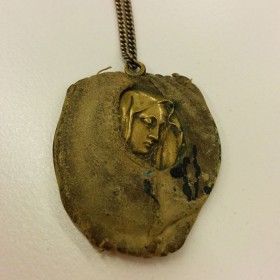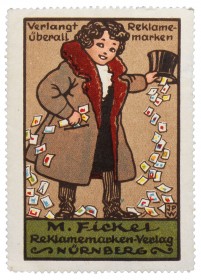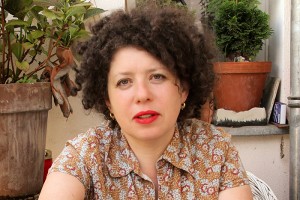An extraordinary gift

Medallion with the image of a saint © Jewish Museum Berlin, photo: Jörg Waßmer, gift of Fred Kranz
Last week, museum benefactor Fred Kranz accepted our invitation to participate in two workshops in our archives. He met with two classes of schoolchildren, one from Döbeln in Saxony and the other from Berlin’s Tegel district. It was the fifth time in recent years that Mr. Kranz – who was born in Berlin in 1938 – came back from the USA to speak to students and their parents about his life. The Kranz family, which consisted of Fred and his parents, survived the war living on a farm that belonged to a former employee of his father, in the village of Kallinchen on Motzener See (Lake Motzen) in Brandenburg.
In 2004, Fred Kranz donated a collection of documents and photographs to the museum that provide an impressive record of Jewish life in the years immediately following the war. During his most recent visit, he gave us a very special – a truly unique – object. Here is the story of this piece, in his words: → continue reading
“Poster stamps?” A short pause, a puzzled look. “And… what are poster stamps?” This was more or less the reaction of every one of my friends and acquaintances when I told them these last months about ‘what I’m working on at the museum right now’. Namely, an exhibition on poster stamps.

Poster stamp from the publisher M. Fickel © Jewish Museum Berlin, photo: Jens Ziehe, gift of Peter-Hannes Lehmann
Poster stamps, I would answer, are small promotional pictures, a little bigger than stamps. They were used as advertisements for products and stores just about exactly a hundred years ago. Some of the stamps were designed by well-known artists like Lucian Bernhard and people would collect them, particularly children.
I didn’t know much more than that about these poster stamps before I started researching for our cabinet exhibition “Pictures Galore and Collecting Mania – Advertising in Miniature”. The show begins on 4. December, 2014 and lasts until 31. May, 2015 at the Rafael Roth Learning Center. To learn more about the relevance that the stamps had before World War I, I began reading contemporary advertising manuals and magazines.
At first I found relatively little on the subject, → continue reading
With her works for our art vending machines, Deborah Wargon exposes things that got swept under the rug

Portrait of Deborah Wargon © Jewish Museum Berlin, photo: Gelia Eisert
A cordial welcome, the wafting flavors of a freshly-cooked meal, a light-drenched room with a high ceiling, full of brightly-colored books and pictures, and a piano with a sign-post ‘to Australia’ sitting on it… My first encounter with Deborah Wargon in her live-in atelier in Berlin’s Prenzlauer Berg neighborhood is a far cry from the rather severe, somber associations that the term ‘testament enforcer’ brings up for me. Wargon – a musician as well as visual and theater artist born in Melbourne in 1962 – describes herself this way on the package insert that comes with the small-scale artworks that she created for the art vending machine in our permanent exhibition. Those artworks bear the title “The Legacy of Friede Traurig” – where Friede Traurig doubles as a proper name and, in German, to mean peace sorrowful. And Deborah Wargon, who is best known for her paper cuttings inside former insect cases, says that she would rather be sorrowful.
With a little good luck, you may get one of her works from the vending machine: for instance, a little human figurine made of rail track ballast (gravel), wire, and newspaper. Aside from the expressive name Friede Traurig, the materials invoke woeful stories of train transports and barbed wire fences, particularly because the newspapers she used are from the Second World War. But for the artist, it’s clearly not only about the specific time the Nazis were in power and the Shoah. It’s also about the legacies, the inheritance, the stories that we all carry with us. She explains her choice of materials: “For me, wire is a fascinating material. It’s also used for cages. So you can use to suggest the ways that we’re all captive.” The rail track gravel, which normally lies on the ground, relates for Wargon to the ground that we all walk on, as descendants of the people who came before us. “Besides, in both German and English there’s the expression ‘to sweep something under the rug’”. The gravel, or grit, that we bring into the house on the soles of our shoes, and then sweep under the rug, stands for something that we don’t want to face and deal with.
→ continue reading


